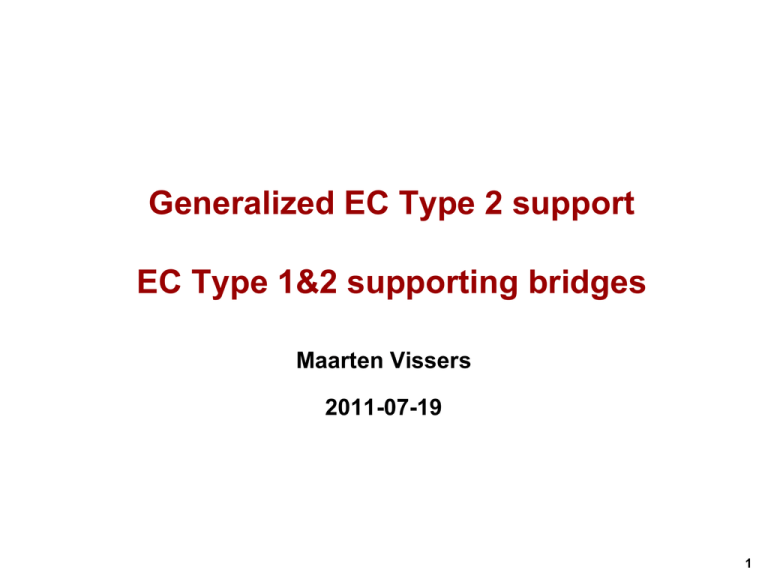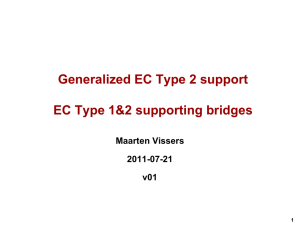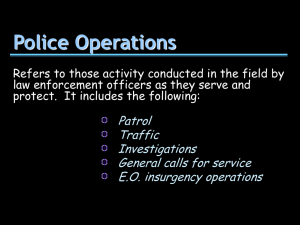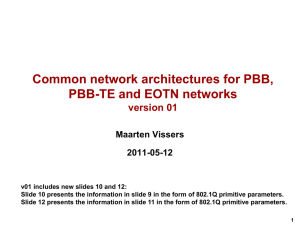Generalized EC Type 2 support EC Type 1&2 supporting bridges
advertisement

Generalized EC Type 2 support EC Type 1&2 supporting bridges Maarten Vissers 2011-07-19 1 Introduction http://www.ieee802.org/1/files/public/docs2011/new-vissers-pbb-pbbteeotn-common-network-arch-0511-v01.pptx presented common network architectures for PBB, PBB-TE and EOTN networks to determine the Tagging method of EC Type 2 signals in an EOTN The last two slides in the above presentation indentified implications of the Tagging methods within PB, PBB I and PBB-TE networks These slides were not addressed in Santa Fe meeting due to time constraints This new presentation addresses the implications of the choice of I+STagging of EC Type 2 signals in PB, PBB I and PBB-TE networks Furthermore, this presentation presents some initial feedback on the tagging choice 2 EC Type 2 support beyond PBB and EOTN One may expect that EC Type 2 signal support will be required beyond the PBB II and EOTN networks in future; e.g. in EoSDH, EoMPLS(-TP)/VPLS, PBB-TE, PBB I and PB networks EoSDH transports S-Tagged EC Type 1 signals via GFP-F over SDH VC-n connections; this is a similar environment as in EOTN and I+S-Tagged EC Type 2 signals would be applicable PB, PBB-TE and PBB I transport S-Tagged EC Type 1 signals; should/could EC Type 2 signals be transported with I+STags? NOTE: EC Type 2 support in EoMPLS(-TP)/VPLS is TBA 3 EC frame tagging in PB, PBB, PBB-TE, EOTN Network PB + PBB I (PEB, PB, IB-BEB, BCB only) PB + PBB II (PEB, PB, IB-BEB, TB-BEB, I-BEB, BBEB, BCB) PB + PBB-TE (PEB, PB, IB-BEB, BCB) EOTN (TEB,TB, OTN XC) EC Type 1 frame tag EC Type 2 frame tag S-Tag I+S-Tag ? Note: in B-VLAN an I-Tag or S+I-Tag is used S-Tag I-Tag Note: Inside PBB network the EC frames are carried inside a 2nd EC frame, which is I-Tagged S-Tag I+S-Tag ? Note: in ESP an I-Tag or S+I-Tag is used S-Tag I+S-Tag Note: agreed in Santa Fe meeting EC Type 1: EC carrying an EVC which is not-MAC-in-MAC encapsulated EC Type 2: EC carrying an EVC which is MAC-in-MAC encapsulated 4 EC Type 1 & 2 supporting Provider Edge Bridge (PEB2) Tributary Port functonality Line Port functionality EC Type 1&2 supporting PEB PNP To/from PEB & PEB2 & PB & PB2 & IBBEB PNP & IBBEB2 & MEF E-NNI PNP PEP PNP CNP PEP CBP CBP CNP PNP PNP CNP CBP CBP B-Component PNP C-Tagged Service Interface (un-, priority-C-. C-Tagged) C-VLAN Component CEP Port Based Service Interface (un- C-, priority-S- I-Tagged) S-Tagged Service Interface (S-Tagged) Individual S-VLAN Service B-Component B-Component PNP PNP CBP CBP EC Type 1&2 PNP ports in PEB node are replaced by B-component complex to support EC Type 2 MEPs and MIPs Remote Customers C-Tagged service interface CNP PEP CNP PEP CNP S(B)-VLAN Component S-Tagged LANs CNP CNP C-VLAN Component CEP Remote Customer Portbased Service Interface Remote Customers S-Tagged Service interface PAP Port-based, S- & C-Tagged Service Interface (S-, S+C-Tagged) RCAP S-VLAN Component PAP EC Type 1 PNP I-Tagged service interface (I-Tagged) Individual or bundled I-Tagged Services CBP CBP PIP CBP PIP EC Type 2 UNI-N tributary ports are added to PEB node CNP PEP C-VLAN Component CEP C-Tagged Service Interface (un-, priority-C-, C-Tagged) CNP PEP CNP Port Based Service Interface (un-, C-, priority-S- I-Tagged) CNP S-Tagged Service Interface (S-Tagged) Remote Customers C-Tagged service interface IComponent CNP PEP CNP PEP CNP CNP C-VLAN Component CEP Remote Customer Portbased Service Interface Remote Customers S-Tagged Service interface PAP S-VLAN RCAP Component Port-based , S- & C-Tagged Service Interface (S-, S+C-Tagged) PAP PNP Transparent Service Interface (un-, C-, S-, I-Tagged) CBP TPIP Component CNP EC Type 2 5 EC Type 1&2 supporting PB EC Type 1 signals EC Type 2 signals PNP ports in PB node are replaced by B-component complex to support EC Type 2 MEPs and MIPs B-Com- PNP PNP ponent CBP PNP CBP PNP2 = EC Type 1 & 2 supporting PNP EC Type 1 & 2 supporting Provider Bridge (PB2) S-Tagged LANs PNP PNP PNP B-Component B-Component B-Component PNP PNP CBP CBP PNP PNP CBP CBP PNP PNP CBP CBP Line Port functionality S(B)-VLAN Component Line Port functionality PNP PNP CBP CBP PNP PNP CBP CBP PNP PNP CBP CBP B-Component B-Component B-Component S-Tagged LANs PNP PNP PNP NOTE: BCB node does not need to support EC Type 2 6 EC Type 1&2 supporting PBB-TE IB-BEB CNP and PIP ports in PBB-TE IB-BEB node are replaced by Bcomponent complex to support EC Type 2 MEPs and MIPs EC Type 1 & 2 supporting PBB-TE IB Backbone Edge Bridge (IB-BEB2) EC Type 1 & 2 signals must pass through I-Component - ESP-MAC is not the same as B-MAC B-Tagged LANs PNP PNP PNP B-VLAN Component PNP CBP CBP CBP CBP PIP PIP PIP PIP B-Component B-Component B-Component B-Component PNP PNP CBP CBP PNP PNP PNP CBP IComponent PNP PNP PNP CBP CBP CBP PNP PNP PNP PNP CBP PNP PNP CBP CBP IComponent CBP PNP CBP S-Tagged LAN CNP CBP CBP CBP B-Component B-Component B-Component S-Tagged LAN CNP S-Tagged LAN CNP CBP PNP B-Component S-Tagged LAN CNP CBP 7 EC Type 1&2 supporting PBB I IB-BEB CNP ports in PBB I IB-BEB node are replaced by Bcomponent complex to support EC Type 2 EC Type 1 & 2 supporting PBB I IB Backbone Edge Bridge (IB-BEB2) B-Tagged LANs CBP PNP PIP PNP PNP B-VLAN Component CBP PNP CBP CBP PNP IComponent PNP PIP CBP PNP PNP B-Com- CBP PIP CBP CBP S-Tagged LAN CNP ponent CNP B-Component CNP S-Tagged LAN CBP CBP CBP B-Component EC Type 2 signals can bypass I-Component PNP IComponent PNP PIP S-Tagged LAN CBP PNP B-Component CNP S-Tagged LAN CBP 8 Initial feedback I+S-Tagged EC Type 2 OAM is not acceptable EC Type 2 OAM should be S-Tagged like EC Type 1 OAM Use of S-Tagged EC Type 2 OAM will allow reuse of existing EC Type 1 NNI ports in packet and packet-optical transport networks Considerations I-Tagged LANs are not in the network/do not exist I-Tagged Ethernet OAM (BSI OAM) is not in the network/does not exist PBB network deployments are single domain PBB networks with STagged LAN ingress/egress interfaces No need for EC Type 2 to interwork with PIP in IB-BEB 9 How to continue? Ignore initial feedback and continue with I+S-Tagged EC-Type 2 OAM in standards? Extend 802.1Q PEB, PB, PBB I IB-BEB and PBB-TE IB-BEB nodes with I+S-Tagged EC Type 2 MEP and MIP support Let ITU-T SG15 add I+S-Tagged EC Type 2 specifications to its transport network recommendations Build equipment with (non-standard) S-Tagged EC Type 2 OAM support Revise our May 2011 decision? Consider that BEBs are used only within the network, not as Network Termination (NT)/Network Interface Device (NID); i.e. BEBs have no UNI-N ports, BEBs only have NNI ports Extend 802.1Q PEB node with EC Type 2 UNI-N ports and STagged EC Type 2 OAM 10 Backup EC Type1 and EC Type 2 examples including EC/ESP layer stack and EC/ESP identifiers EC Type1 and EC Type 2 (un)tagged primitive formats 11 1. PBB I and PBB-TE network EVC(C-VLAN) via EC Type 1 S-VID Translation locations CNP2 CNP2 S CNP2 CNP2 S S CNP2 B(I) B(I) BCB B(I) IB-BEB2 B(I) BCB PNP CNP2 IB-BEB2 PEB S PEB2 UNI CEP UNI CNP UNI CNP2 B(I) BCB S mp2mp B-VLAN or p2p TESI UNI IB-BEB2 B(I) IB-BEB2 B(I) CNP2 S IB-BEB2 S BCB PNP2 CNP2 IB-BEB2 UNI CEP CNP2 mp2mp B-VLAN or p2p TESI • EVC = C-VLAN • EC Type 1 • S-VID Translation at PBBN domain boundaries (in CNP2) • PBB I: few mp2mp BVLANs in each domain; B-MAC per domain • PBB-TE: full mesh of p2p TESIs in each domain; ESP-MAC per domain • no MAC address collisions in PBBN domains (multiple single-domain PBBNs) PEB2 UNI CNP2 mp2mp B-VLAN or p2p TESI PNP2 12 2. PBB I and PBB-TE network EVC(S-VLAN) via EC Type 2 S-VID/I-SID Translation locations B(I) BCB B(I) IB-BEB2 B(I) CNP2 S IB-BEB2 S BCB PNP2 CNP2 IB-BEB2 UNI CEP CNP2 CNP2 S CNP2 mp2mp B-VLAN or p2p TESI mp2mp B-VLAN or p2p TESI S CNP2 CNP2 S S B(I) BCB B(I) B(I) CNP2 IB-BEB2 B(I) IB-BEB2 PNP BCB S CNP2 IB-BEB2 UNI CEP UNI CNP UNI CNP2 PEB UNI PEB2 • EVC = S-VLAN • EC Type 2, “Service BMAC” from UNI-N to UNI-N • S-VID/I-SID Translation at PBBN domain boundaries (in CNP2) • PBB I: few mp2mp BVLANs in each domain; B-MAC per domain • PBB-TE: full mesh of p2p TESIs in each domain; ESP-MAC per domain • no MAC address collisions in PBBN domains (multiple single-domain PBBNs) PEB2 UNI CNP2 mp2mp B-VLAN or p2p TESI PNP2 13 Layer stack PB + PBB-TE for EVC(C-VLAN) via EC Type 1 S-VID is optional; typically not present in a 1:1 case C-MAC EVC C-VID EC (Type 1 and Type 2) S-VID EC (link) S-VID I-SID S-VID S-VID I-SID S-VID S-VID I-SID S-VID ESP EC ESP EC ESP EC ESP-MAC ESP-VID PHY EC EC PHY PHY ESP-MAC ESP-VID PHY EC EC PHY PHY ESP-MAC ESP-VID PHY EC EC PHY PHY PHY 14 Layer stack PB + PBB-TE for EVC(S-VLAN) via EC Type 2 I-SID = S-VID+4096 S-VID is optional; typically not present in a 1:1 case C-VID EVC S-VID Service B-MAC EC (Type 1 and Type 2) I-SID S-VID I-SID S-VID I-SID EC I-SID S-VID ESP EC ESP-MAC ESP-VID PHY I-SID S-VID I-SID EC EC PHY PHY I-SID S-VID ESP EC ESP-MAC ESP-VID PHY EC EC PHY PHY I-SID S-VID I-SID S-VID I-SID ESP EC ESP-MAC ESP-VID PHY EC EC PHY PHY PHY 15 Layer stack PB + PBB I for EVC(C-VLAN) via EC Type 1 S-VID is optional; typically not present in a 1:1 case C-MAC EVC C-VID EC (Type 1 and Type 2) EC (link) S-VID I-SID B-MAC EC(BVLAN) S-VID S-VID I-SID B-MAC S-VID S-VID I-SID B-MAC EC EC(BVLAN) EC EC(BVLAN) B-VID B-VID PHY EC EC PHY PHY PHY EC B-VID EC EC PHY PHY PHY EC EC PHY PHY PHY 16 Layer stack PB + PBB I for EVC(S-VLAN) via EC Type 2 S-VID is optional; typically not present in a 1:1 case I-SID = S-VID+4096 C-VID EVC S-VID Service B-MAC EC (Type 1 and Type 2) I-SID S-VID EC I-SID S-VID I-SID B-MAC EC(BVLAN) I-SID S-VID I-SID S-VID I-SID S-VID I-SID B-MAC EC EC(BVLAN) EC EC(BVLAN) B-VID B-VID PHY EC EC PHY PHY I-SID S-VID I-SID S-VID I-SID B-MAC PHY EC B-VID EC EC PHY PHY PHY EC EC PHY PHY PHY 17 3. PBB II network EVC(C-VLAN) via EC Type 1 I-SID Translation locations S-VID Translation locations CBP CBP mp2mp B-VLAN S CNP2 I CBP B-BEB B(I) CBP I B-BEB B(I) BCB PNP CBP IB-BEB2 S PEB2 UNI CEP UNI CNP UNI CNP2 PEB UNI BCB I B(I) B(I) B(I) BCB B(I) B-BEB B(I) CBP I B-BEB S BCB PNP2 CBP IB-BEB2 UNI CEP CNP2 mp2mp B-VLAN • EVC = C-VLAN • EC Type 1 • EC Type 1 over EC(BSI) in PBBN • S-VID Translation at PBBN network boundary (in CNP2) • I-SID Translation at PBBN domain boundaries (in CBP) • PBB II: few mp2mp BVLANs in each domain; B-MAC per network • potential MAC address collisions in PBBN domains PEB2 UNI CBP mp2mp B-VLAN PNP2 18 4. PBB II network EVC(S-VLAN) via EC Type 2 I-SID Translation locations S-VID Translation locations CBP CBP mp2mp B-VLAN S CNP2 I CBP B-BEB B(I) CBP I B-BEB B(I) BCB PNP CBP IB-BEB2 S PEB2 UNI CEP UNI CNP UNI CNP2 PEB UNI BCB I B(I) B(I) B(I) BCB B(I) B-BEB B(I) CBP I B-BEB S BCB PNP2 CBP IB-BEB2 UNI CEP CNP2 mp2mp B-VLAN • EVC = S-VLAN • EC Type 2, “Service BMAC” from UNI-N to UNI-N • EC Type 2 over EC(BSI) in PBBN • S-VID Translation at PBBN network boundary (in CNP2) • I-SID Translation at PBBN domain boundaries (in CBP) • PBB II: few mp2mp BVLANs in each domain; B-MAC per network • potential MAC address collisions in PBBN domains PEB2 UNI CBP mp2mp B-VLAN PNP2 19 Layer stack PB + PBB II for EVC(C-VLAN) via EC Type 1 S-VID is optional; typically not present in a 1:1 case C-MAC EVC C-VID EC (Type 1 and Type 2) S-VID B-MAC S-VID EC PHY S-VID EC(BSI) EC I-SID I-SID I-SID I-SID I-SID EC(BVLAN) EC EC(BVLAN) EC EC(BVLAN) B-VID B-VID EC EC PHY PHY PHY PHY B-VID EC EC PHY PHY PHY EC EC PHY PHY 20 Layer stack PB + PBB II for EVC(S-VLAN) via EC Type 2 I-SID = S-VID+4096 C-VID EVC S-VID Service B-MAC EC (Type 1 and Type 2) I-SID S-VID I-SID S-VID I-SID I-SID I-SID I-SID I-SID EC(BVLAN) EC EC(BVLAN) EC EC(BVLAN) EC EC B-VID B-VID EC EC PHY EC B-VID EC PHY EC EC PHY PHY PHY PHY PHY PHY PHY PHY 21 EC Type 1 Tag TPID = 88-a8 PCP DEI EC Type 1 primitive parameters - destination_address - source_address - priority - drop_eligible - mac_service_data_unit = S-Tagged EC Type 1 primitive parameters - destination_address - source_address - priority - drop_eligible - mac_service_data_unit = Type <> 89-10 Type <> 89-10 MSDU MSDU S-Tagged EC Type 1 OAM primitive parameters - destination_address - source_address - priority - drop_eligible - mac_service_data_unit = TPID = 88-a8 PCP DEI EC Type 2 OAM primitive parameters - destination_address (=B-DA) - source_address (=B-SA) - priority - drop_eligible - mac_service_data_unit = S-VID S-VID Type = 89-02 Type = 89-02 OAM PDU OAM PDU 22 I-SID PCP 0 Res2 I-SID C-DA C-DA I-SID = S-VID + 4096 C-DA C-SA Type C-SA Type C-SA Type MSDU MSDU MSDU I-SID I-SID C-DA = B-DA C-SA = B-SA Type = 89-02 OAM PDU EC Type 2 OAM primitive parameters - destination_address - source_address - priority - drop_eligible - mac_service_data_unit = TPID = 88-a8 PCP PCP S-VID TPID = 88-E7 1 Res1 Res2 (destination address = f(B-DA,DBD) I+S-Tagged EC Type 2 OAM primitive parameters -destination_address - source_address - priority - drop_eligible - mac_service_data_unit = DEI Res1 DEI TPID = 88-E7 Type = 89-10 TPID = 88-E7 0 S-VID I-SID I-Tagged EC Type 2 OAM primitive parameters - destination_address - source_address - priority - drop_eligible - mac_service_data_unit = PCP PCP Res1 Res2 TPID = 88-a8 DEI 0 Res1 PCP DEI TPID = 88-E7 EC Type 2 primitive parameters - destination_address - source_address - priority - drop_eligible - mac_service_data_unit = DEI I-Tagged EC Type 2 primitive parameters -destination_address - source_address - priority - drop_eligible - mac_service_data_unit = I+S-Tagged EC Type 2 primitive parameters -destination_address - source_address - priority - drop_eligible - mac_service_data_unit = DEI EC Type 2 Tag Res2 I-SID I-SID = S-VID + 4096 C-DA = B-DA Type = 89-02 C-SA = B-SA Type = 89-02 OAM PDU OAM PDU 23








